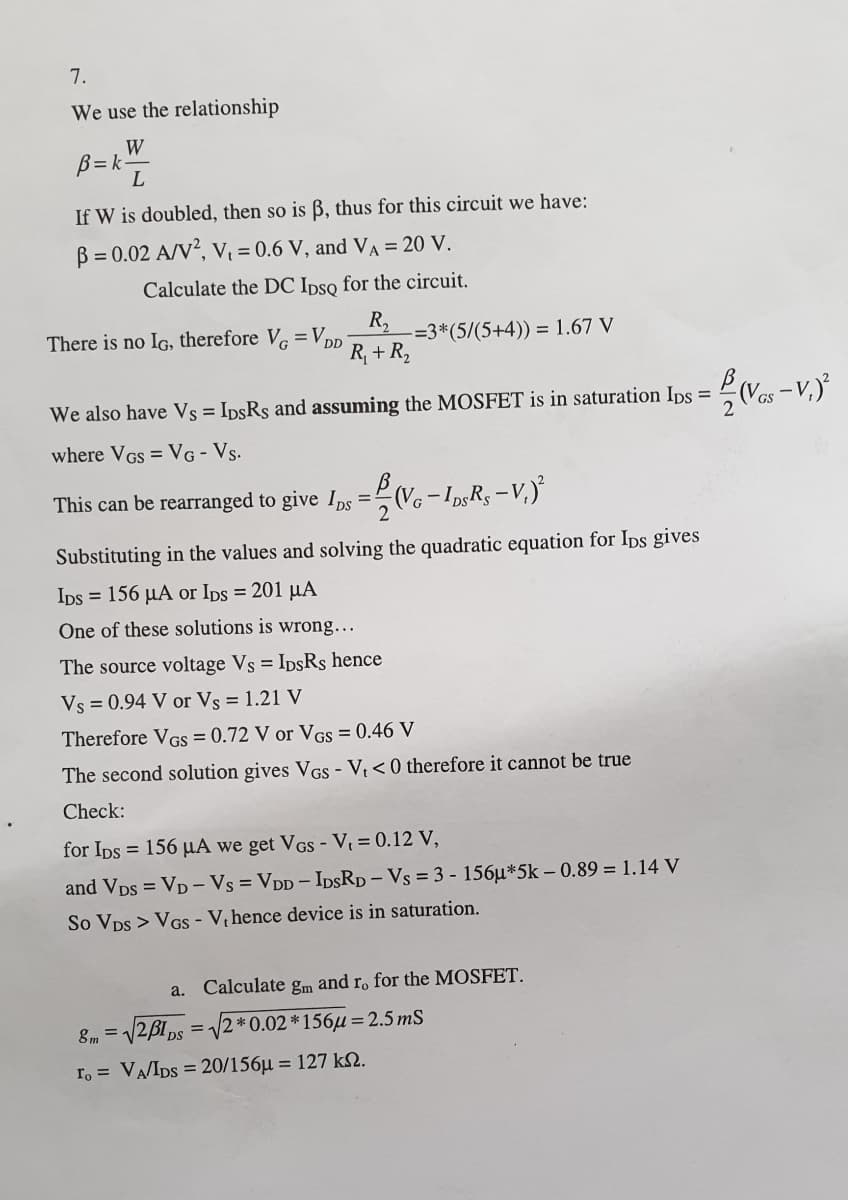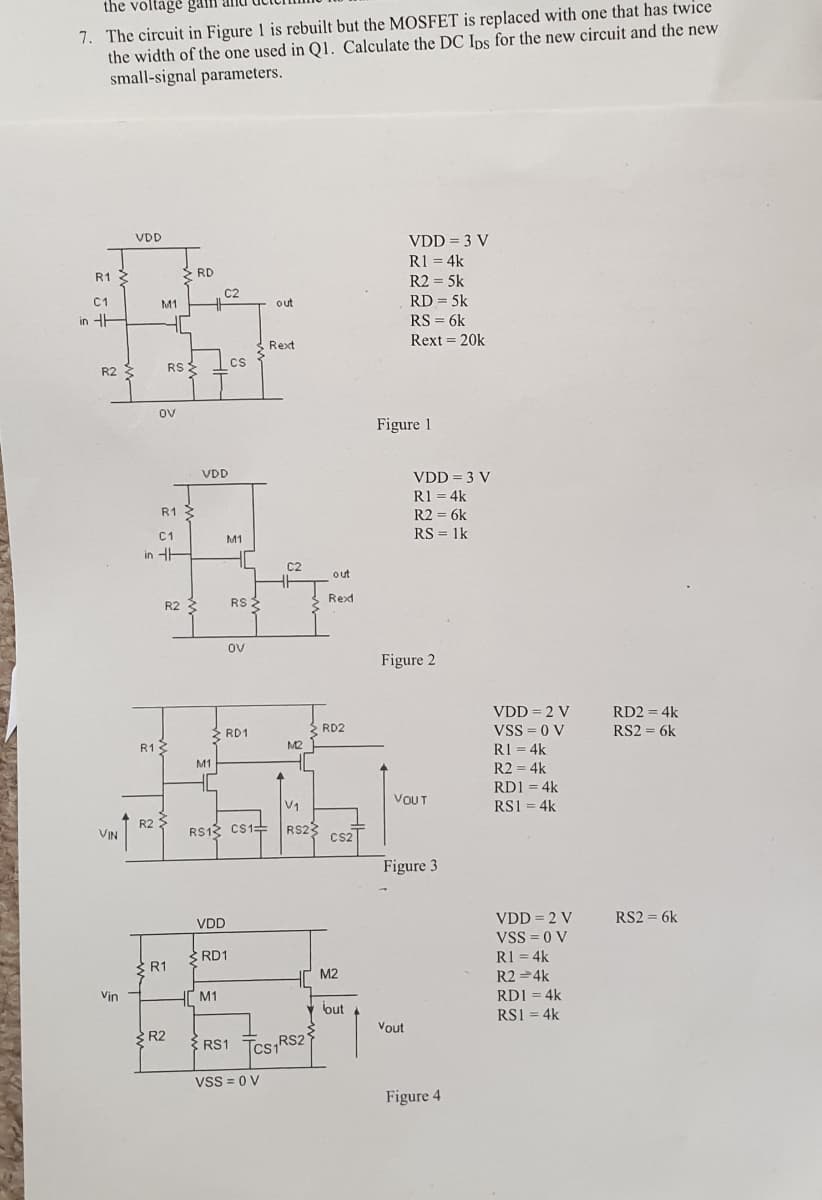7. We use the relationship W B= k= If W is doubled, then so is B, thus for this circuit we have: B = 0.02 A/V, V = 0.6 V, and VA = 20 V. %3D Calculate the DC Ipso for the circuit. R, There is no IG, therefore V =VpD -=3*(5/(5+4)) = 1.67 V R, + R, We also have Vs = IpsRs and assuming the MOSFET is in saturation Ips = (Ves -V,) GS where VGs = VG- Vs. This can be rearranged to give Ips =(Vc- InsRs-V,) Substituting in the values and solving the quadratic equation for Ips gives Ips = 156 µA or Ips = 201 µA %3D One of these solutions is wrong... The source voltage Vs = IpsRs hence Vs = 0.94 V or Vs = 1.21 V Therefore VGS = 0.72 V or VGS = 0.46 V %3D The second solution gives VGS - V <0 therefore it cannot be true Check: for Ips = 156 µA we get VGS - V = 0.12 V, and Vps = VD - Vs = VDD - IDSRD - Vs = 3 - 156µ*5k – 0.89 = 1.14 V %3D %3D So Vps > VGS - V, hence device is in saturation. ond r for the MOSFET.
7. We use the relationship W B= k= If W is doubled, then so is B, thus for this circuit we have: B = 0.02 A/V, V = 0.6 V, and VA = 20 V. %3D Calculate the DC Ipso for the circuit. R, There is no IG, therefore V =VpD -=3*(5/(5+4)) = 1.67 V R, + R, We also have Vs = IpsRs and assuming the MOSFET is in saturation Ips = (Ves -V,) GS where VGs = VG- Vs. This can be rearranged to give Ips =(Vc- InsRs-V,) Substituting in the values and solving the quadratic equation for Ips gives Ips = 156 µA or Ips = 201 µA %3D One of these solutions is wrong... The source voltage Vs = IpsRs hence Vs = 0.94 V or Vs = 1.21 V Therefore VGS = 0.72 V or VGS = 0.46 V %3D The second solution gives VGS - V <0 therefore it cannot be true Check: for Ips = 156 µA we get VGS - V = 0.12 V, and Vps = VD - Vs = VDD - IDSRD - Vs = 3 - 156µ*5k – 0.89 = 1.14 V %3D %3D So Vps > VGS - V, hence device is in saturation. ond r for the MOSFET.
Introductory Circuit Analysis (13th Edition)
13th Edition
ISBN:9780133923605
Author:Robert L. Boylestad
Publisher:Robert L. Boylestad
Chapter1: Introduction
Section: Chapter Questions
Problem 1P: Visit your local library (at school or home) and describe the extent to which it provides literature...
Related questions
Question
Explain the answers

Transcribed Image Text:7.
We use the relationship
W
B= k
L
If W is doubled, then so is B, thus for this circuit we have:
B = 0.02 A/V?, V = 0.6 V, and VA = 20 V.
Calculate the DC Ipso for the circuit.
R,
=3*(5/(5+4)) = 1.67 V
R, + R,
There is no IG, therefore Ve =Vp.
Va -v.
We also have Vs = IpsRs and assuming the MOSFET is in saturation Ips =
where VGs = VG - Vs.
This can be rearranged to give Ips =(Vc - IpgRs –V,)'
2
Substituting in the values and solving the quadratic equation for Ips gives
Ips = 156 µA or Ips = 201 µA
One of these solutions is wrong.….
The source voltage Vs = IpsRs hence
Vs = 0.94 V or Vs = 1.21 V
Therefore VGS = 0.72 V or VGs = 0.46 V
The second solution gives VGs - V, < 0 therefore it cannot be true
Check:
for Ips = 156 µA we get VGs - V = 0.12 V,
and Vps = VD - Vs = VDD - IDSRD - Vs = 3 - 156µ*5k – 0.89 = 1.14 V
So Vps > VGS - V, hence device is in saturation.
a. Calculate gm and r, for the MOSFET.
8m = 2B1 ps = /2 *0.02 *156µ = 2.5 mS
ro = VA/IDs = 20/156µ = 127 kN.

Transcribed Image Text:7. The circuit in Figure 1 is rebuilt but the MOSFET is replaced with one that has twice
the width of the one used in Q1. Calculate the DC Ips for the new circuit and the new
small-signal parameters.
the voltagé gain
VDD = 3 V
R1 = 4k
VDD
R1 2
2 RD
R2 = 5k
C2
RD = 5k
RS = 6k
C1
M1
out
in HE
Rext = 20k
Rext
CS
R2
RS:
ov
Figure 1
VDD
VDD = 3 V
R1 = 4k
R2 = 6k
RS = 1k
R1
C1
M1
in HE
C2
out
Rexd
R2 3
RS2
ov
Figure 2
VDD = 2 V
RD2 = 4k
2 RD2
VSS = 0 V
RI = 4k
R2 = 4k
RD1
RS2 = 6k
R13
M2
M1
RD1 = 4k
VOUT
V1
RS1 = 4k
R2
RS13 CS1=
RS23
Cs2
VIN
Figure 3
VDD = 2 V
RS2 = 6k
VDD
VsS = 0 V
RI = 4k
RD1
R1
R2 =4k
RD1 = 4k
M2
Vin
HT M1
but
RSI = 4k
Vout
R2
{ RS1 Tcs RS2
VSS = 0 V
Figure 4
Expert Solution
This question has been solved!
Explore an expertly crafted, step-by-step solution for a thorough understanding of key concepts.
Step by step
Solved in 5 steps with 2 images

Knowledge Booster
Learn more about
Need a deep-dive on the concept behind this application? Look no further. Learn more about this topic, electrical-engineering and related others by exploring similar questions and additional content below.Recommended textbooks for you

Introductory Circuit Analysis (13th Edition)
Electrical Engineering
ISBN:
9780133923605
Author:
Robert L. Boylestad
Publisher:
PEARSON

Delmar's Standard Textbook Of Electricity
Electrical Engineering
ISBN:
9781337900348
Author:
Stephen L. Herman
Publisher:
Cengage Learning

Programmable Logic Controllers
Electrical Engineering
ISBN:
9780073373843
Author:
Frank D. Petruzella
Publisher:
McGraw-Hill Education

Introductory Circuit Analysis (13th Edition)
Electrical Engineering
ISBN:
9780133923605
Author:
Robert L. Boylestad
Publisher:
PEARSON

Delmar's Standard Textbook Of Electricity
Electrical Engineering
ISBN:
9781337900348
Author:
Stephen L. Herman
Publisher:
Cengage Learning

Programmable Logic Controllers
Electrical Engineering
ISBN:
9780073373843
Author:
Frank D. Petruzella
Publisher:
McGraw-Hill Education

Fundamentals of Electric Circuits
Electrical Engineering
ISBN:
9780078028229
Author:
Charles K Alexander, Matthew Sadiku
Publisher:
McGraw-Hill Education

Electric Circuits. (11th Edition)
Electrical Engineering
ISBN:
9780134746968
Author:
James W. Nilsson, Susan Riedel
Publisher:
PEARSON

Engineering Electromagnetics
Electrical Engineering
ISBN:
9780078028151
Author:
Hayt, William H. (william Hart), Jr, BUCK, John A.
Publisher:
Mcgraw-hill Education,